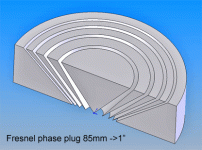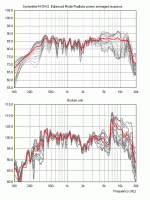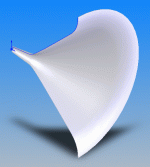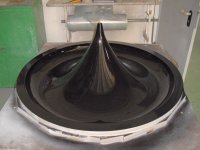Still can't find meaning of this numbers. Centroid is just mass center.
Those are the radi to the Fresnel zones "centroid radius" in the case where n = 4. They are the radi where the areas of the zones are equal. "Centroid" does not mean "mass center". It can, but doesn't here. It means "area center", as I said.
Does 1" throat waveguides/horns generally beam more then 2" throat ones?
Generally the opposite is true, but the waveguide design and not the throat size is the more important factor.
Generally the opposite is true, but the waveguide design and not the throat size is the more important factor.
Interesting. That is counter-intuitive.
It depends on many factors as to what frequency range, mouth size, throat size, length, profile, etc.Does 1" throat waveguides/horns generally beam more then 2" throat ones?
Interesting. That is counter-intuitive.
It should not be counter-intuitive that a larger area should be more directional. Directivity is like a Fourier Transform (actually it IS a FT) where a larger spread in the source yields a narrower spread in the polar distribution. Hence while it is theoretically possible to get a 2" throat to have a wide directivity at higher frequencies, it is a lot easier with a smaller throat. I have yet to measure a commercial 2" throat driver that can do 10 kHz with a wide coverage, while almost any 1" can do that easily. In a nut shell a 2" driver will always require a third driver for the very high end and a dreaded crossover in a critical frequency region - a serious complication (and compromise) in the design IMO.
Just to add to the good Doctor's comment, I do have a 1" compression driver that is not doing wide dispersion at 10k in a horn. In fact it's very narrow. More narrow than a 3"full range driver I have measured. So the design of the flair, motor and diaphragm is still critical even for a 1" driver if you want wide dispersion at 10k. It certainly seems like a worthy goal.
Dan
Dan
Those are the radi to the Fresnel zones "centroid radius" in the case where n = 4. They are the radi where the areas of the zones are equal. "Centroid" does not mean "mass center". It can, but doesn't here. It means "area center", as I said.
I know Fresnel zones are of equal area, so 0.528 is 0.528" or 52,8% of radius or...?
I know Fresnel zones are of equal area, so 0.528 is 0.528" or 52,8% of radius or...?
You are not reading the description of the figures. The area of the sum of the Fresnel zones is normalized to be 1.0. This makes the radius = 1 / sqr( PI) or .564, in whatever units the area is measured in. Just read the patent. It's all correct and seems perfectly clear to me. The examiner understood it!! And thats unusual!
For example, if the throat radius is .5 then you would have to multiple all the numbers by .89 - get it? I could just as easily have normalized to a unit radius (i.e. multiple all the numbers by 1 / .564), etc. But I choose area. You have to normalize to something or it doesn't make sense.
Last edited:
It should not be counter-intuitive that a larger area should be more directional. Directivity is like a Fourier Transform (actually it IS a FT) where a larger spread in the source yields a narrower spread in the polar distribution. Hence while it is theoretically possible to get a 2" throat to have a wide directivity at higher frequencies, it is a lot easier with a smaller throat. I have yet to measure a commercial 2" throat driver that can do 10 kHz with a wide coverage, while almost any 1" can do that easily. In a nut shell a 2" driver will always require a third driver for the very high end and a dreaded crossover in a critical frequency region - a serious complication (and compromise) in the design IMO.
NM, I read it the other way around.
 My mistake
My mistakeNM, I read it the other way around.My mistake
New Yorkers!! CheesSS!
Ok. Mr. Geddes I think I understand. This is how it looks for 85mm flat driver and 1" throat. I'm not sure if unequal paths will work.
Well I'm not gonna comment right or wrong, but the path lengths do need to be of equal length that is certainly true.
Looks like an interesting concept. Anyone doing sims on this? Looks like it could change the power response.Ok. Mr. Geddes I think I understand. This is how it looks for 85mm flat driver and 1" throat. I'm not sure if unequal paths will work.
Last edited:
Surprisingly I've found that Fresnel zones aren't equal - I've normalized radiuses to 0.564. Nevertheless I have modal transducer so intuition suggest to make nodal map and put channels on first three or four modes.
Here's my horn driver candidate.
Back to the drawing board I guess. Not quite as easy as it looks?
- Home
- Loudspeakers
- Multi-Way
- Geddes on Waveguides



